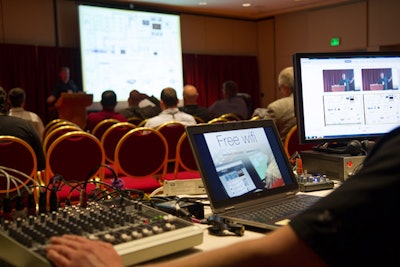
Whether you're considering making your next conference a hybrid event, or you’ve been offering an online component for years, it's still helpful to learn from others. We asked six event professionals to share common mistakes they've encountered while running hybrid events. Donny Neufuss is the senior account manager for Mediasite Events by Sonic Foundry; Elizabeth Glau is owner of Building Blocks Social Media; Victoria Fanning is director of hybrid and online meetings for Educause; Michael Doyle is principal of Michael Doyle Partners; Jenise Fryatt is hybrid event researcher and social media strategist at Smarter Shift by the Conference Publishers; and Susan Garcia is the American Payroll Association’s project manager for its Virtual Congress.
1. Producing without first participating
You’ll be more likely to produce an effective hybrid event if you have experienced one first as an online attendee. “Being a participant is the only way to really understand what your attendees experience,” Fryatt says. "You will quickly see what works as far as engaging an audience and what doesn't."
2. Jumping in without a plan
A virtual meeting is more than just sharing some of the content online. “The plan should start with business objectives and goals and contain a plan for audience acquisition, engagement, content, marketing, monetization, technology, production, and measurement,” Doyle says. "The playbook is a summary of the plan and should be provided to everyone who has responsibility or could potentially impact some portion of the hybrid event."
3. Forgetting to market the online component
This is not a time to rely on the “if you build it, they will come” philosophy. When Educause added a virtual component to its annual conference in 2009, it chose not to market the online element until close to the early registration cut-off date for fear it would detract from the face-to-face meeting. “But we rapidly found that cannibalization was not an issue," Fanning says. "So in 2010, '11, and ’12, we changed our marketing tactics to show it is one meeting with two ways of distributing information. We put all the information up at the same time, including the homepage, and the program. And the online piece gets its own marketing plan and support staff working on it."
4. Pricing it too high
Start by looking at other events in your industry to see what they charge for online participation. Some events, such as Sapphire Now, are free, while others offer a mix of free and for-fee content. “My anecdotal research tells me that if you open up one or two sessions—a keynote or a particularly interesting plenary session—and promote it, you’ll generate more engagement and interest in your conference and your industry,” Neufuss says. For another example, see this case study of why the Healthcare Information Management Systems Society lowered the price for the virtual component of its annual conference to just $39.
5. Not testing the technology
Just because it worked perfectly the last time doesn’t mean it will this time. Always run a test to make sure you have the proper connections and bandwidth to provide quality video and audio.
6. Assuming your speakers are prepared to present in a hybrid environment
The speaking skills that work great with in-person attendees, such as moving around the stage, may not translate well on camera. Coach speakers on how to look into the camera periodically to create a connection with the online audience. Some organizations provide one-on-one training for speakers and allow them to practice using the virtual platform.
7. Treating the online audience as an afterthought
Create a strategy to help virtual attendees stay engaged and feel just as valuable as those attending in person (especially since virtual attendees are likely surrounded by distractions). Start with these 15 tips.
8. Giving your virtual host too much to do
A virtual M.C. can help online participants become engaged with the event, but in some instances you may need two people: one who is on camera, talking to the virtual audience, and another who is interacting with virtual attendees through the online platform.
9. Assuming your virtual attendees can participate from start to finish
Often people participate virtually because they can’t commit the time to attend an event in person. Keep that in mind as you determine how to structure the online schedule. For example, consider repeating some content for online participants.
10. Reserving all the fun benefits for in-person attendees
While online attendees can’t attend the conference reception, Neufuss suggests finding other creative ways to share some perks. “Send them the gift bag in advance so they have it on conference day, and reserve a prize for the most engaged remote attendee,” Neufuss says. "A few small touches like these go a long way toward generating goodwill."
11. Paying too little, or too much
Hybrid events can take on many forms, from a simple handheld camera connected to the Internet to elaborate multi-camera productions requiring extensive bandwidth. Align your goals and your budget to find the right solution for your event. One of the biggest expenses can be Internet service, so consider these tips when setting up your Wi-Fi.
12. Overloading your exhibitors
Some planners have found it's too much for exhibitors to manage a booth at the face-to-face event while also responding to inquiries in real time from the virtual audience.
13. Recreating the same event year after year
Online attendees need new reasons to attend, just like those participating in person. Many of the companies that provide virtual event platforms are continually developing new games, surveys, chat options, and other features that can add a fresh experience for the online audience.
14. Not gathering feedback from virtual attendees
Your event survey strategy should incorporate input from both in-person and online participants. Find out what worked and didn’t work before you start planning the next hybrid event.



















